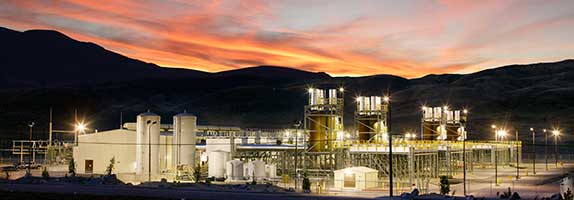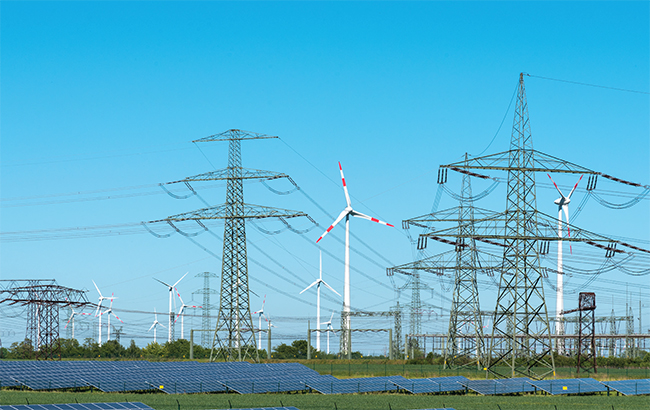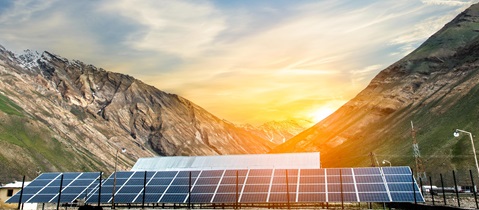

About Marine
Energizing India
Wärtsilä power plants are the ideal solution for decentralized power production and an attractive alternative to the conventional model of centralized power plants.
Wärtsilä’s solutions are available for large plants of 500 + MW capacity. Our gas based power plants are highly flexible and offer the following benefits:
Our power plants can be used for base-load applications or for peak-load needs or to complement wind energy. Our engines can handle liquid fuels such as HFO/LSHS, LFO, LBF or natural gas. Versatile dual-fuel engines can switch between liquid fuel and gas, on line. The CCHP solutions have a very low CO2 footprint, and merit status of ‘deemed renewable energy’.
We provide complete EPC solutions and lifecycle O&M support.
Wärtsilä has been involved with the Indian market for over 25 years, and has an installed base that exceeds 3500 MW, with a large service organisation to provide lifecycle support to customers. Many of the engines have clocked over 1,00,000 hours of operation. The 48MW power plant at Mangalore Chemicals & Fertilisers Ltd has completed 25 years of continuous generation.
For India to take a rightful place in the group of developed nations, electrical energy availability to each section of the population in stable and adequate quantity is a must. Energy demand fluctuates during the course of 24 hours in a day, during passage of different seasons and also sees substantial unpredictability over the years based on climatic condition, political and social expressions and many other factors specific to that year. Introduction of renewable power feed such as wind & solar etc. though extremely desirable from environment & sustainability point of view, adds more unpredictability to the supply-demand situation in the grid.
Wärtsilä leads the transition towards a 100% renewable energy future. We help our customers in decarbonisation by developing market-leading technologies. These cover future-fuel enabled balancing power plants, hybrid solutions, energy storage and optimisation technology, including the GEMS energy management platform. Wärtsilä Energy’s lifecycle services are designed to increase efficiency, promote reliability and guarantee operational performance.
Our track record comprises 74 GW of power plant capacity and more than 80 energy storage systems delivered to 180 countries around the world.

The electricity landscape in India is evolving rapidly. The government is committed to increasing the share of non-fossil fuels in the electricity mix to 50 percent by 2030. Increasing the share of renewables in the electricity mix will make the power system more sustainable. However, the efficient integration of renewables in the grid can be rather cumbersome without suitable balancing resources.
Managing India's power system is becoming increasingly complex as it's resource mix evolves to include more weather dependent, decentralised, and variable renewable energy sources. In order to deal with such complexity, the system operator will need more flexibility to serve load while maintaining grid reliability.
Considering the changing system needs, Wartsila commissioned KPMG to carry out an Ancillary Services Market Study to understand the market structure in India. How can we provide appropriate price signals to reflect both operational and resource requirements while encouraging efficient investment and retirement decisions?
ii.jpg?sfvrsn=40f58544_6)

Wärtsilä, in collaboration with the Lappeenranta-Lahti University of Technology (LUT), has carried out a modelling study to explore the feasibility of a net-zero power system across India by 2050. The findings of the study show that India can undertake a cost-optimal shift to 100% renewable energy (RES) and avoid locking in a highly polluting, more expensive and less effective transition.
India can cut its overall cost of electricity in half and reach net zero before 2050 by developing a 100% renewable energy power system, according to modelling by global technology company Wärtsilä and the Finnish Lappeenranta-Lahti University of Technology.
The modelling shows a clear, actionable pathway to achieve a net zero electricity system that can bring enormous environmental and economic benefits to India, one of the world’s largest and fastest growing economies:
· Increasing renewable energy from 25% today to 100% before 2050 cuts the cost of India’s electricity by 48%, from $88 USD per megawatt hour in 2020, to $46 USD in 2050.
· A flexible 100% renewable system provides large levels of excess power that can address India’s rising energy dependency, forecast to double by 2030.
·
The modelling makes a clear case for immediate action to accelerate the development of a 100% renewable energy system in India. By combining variable renewable power with energy storage and thermal balancing power plants capable of using carbon neutral sustainable fuels in the coming decade, India can dramatically cut its carbon emissions and halve the overall cost of its
Sandeep Sarin, Market Development Manager of India, Wärtsilä Energy, and co-author of the report, said:
“This year, India will become the world’s fastest growing economy. Our modelling shows a path to a clean power system that will catalyse India's transformation into a global clean energy powerhouse; lifting millions from poverty, creating new jobs, insulating the system from energy shocks and simultaneously playing a vital role in limiting global temperature rises to below 1.5°C.
“India has a mountain to climb in reconfiguring its energy system for net zero, but it’s certainly possible with technologies that are already available at scale. With the right vision and planning, India can leapfrog developed nations into a sustainable future, but we must act now, before it’s too late.”
Wärtsilä’s ‘Front-loading Net Zero’ report sets out clear steps for India to decarbonise its power system:
1. Set ambitious clean energy targets over longer-term time horizons to attract investors.
2. Increase climate regulation for companies, including mandating consumers and power producers to meet a certain percentage of their requirements from renewable sources.
3. Strengthen flexibility solutions, such as
4. Launch an incentive programme for production of electrolysers (as capital costs are responsible for 30% of the cost of green hydrogen) and create new demand centres equipped to cost-effectively develop and transport green hydrogen.
As well as showing a path to an affordable clean energy transformation, the modelling also demonstrates the major planning challenge to cleanly meet energy demand as India’s population rises to around 1.7 billion by 2050.
Power demand is estimated to increase by 340% by 2050 – from 1,345 TWh in 2020 to 5,921 TWh in 2050, with 1,023 GW of peak demand. The modelling confirms India can affordably meet this demand through renewable energy, aided by solar energy prices that are amongst the lowest in the world, averaging around $26 USD per MWh[1].
However, to serve this increased load through mid-day peaks and to charge energy storage resources such as batteries to offset intermittent renewable energy generation, the total system capacity must be scaled up to an unprecedented degree:
· 4,000 GW of installed capacity is needed for a 100% renewable system, a 10-fold increase on 2020.
· New solar installations must rise by 885%, from 7 GW a year today, to 69 GW a year by 2035, rising to 79 GW a year between 2035 and 2050.
· Solar would make up 76% (3,076 GW) of total capacity by 2050.
· This would also be supported by a total wind capacity of around 410 GW by 2050, combined with hydro and carbon neutral gas.
To support a 100% renewable energy system in India:
· Energy storage capacity must increase from almost zero to reach 99 TWh of storage capacity by 2050.
· Storage output should cover 35% of India’s total demand by 2050, with 99%
· 187 GW of fast-start load-following gas engines are needed to provide rapid grid balancing.
The report provides a wake-up call to leaders on the need for a comprehensive energy transition plan,
Mr Anish De, Partner, Global Sector Head, Power & Utilities, KPMG National Head - Energy Natural Resources & Chemicals, KPMG in India, said:
“India’s ambition and achievements on renewables are of an unparalleled scale. We have abundant resources for cheap and clean renewable energy – blessed with more than 300 sunny days a year – and our geography provides world-leading wind power.
“With some inventiveness, the right mix of new renewable generation and flexibility can replace coal and gas-fired power, creating a clean and more affordable system. This leaves a key question: is India better off committing itself whole heartedly to a renewable energy future? From every angle, the answer is yes.”
Wärtsilä’s report also lays out the shifting role of gas power in India. The modelling shows that by 2050, thermal balancing power plants will have a relatively small, but crucial, back-up role, providing 1.1% of electricity generation. Thermal balancing power plants will play a crucial role in decarbonising the power system by shifting to carbon neutral, hydrogen-based sustainable fuels, such as synthetic methane, to generate electricity and help decarbonise the final 10% of India’s energy system. Wärtsilä engines are already capable of running on 25% hydrogen blends and the company expects to be capable of running 100% hydrogen by 2025.
Håkan Agnevall, CEO and President of Wärtsilä, said:
“Our modelling shows that it is viable for all energy systems to be fully decarbonised before 2050, and that accelerating the shift to renewable baseload, coupled with flexibility, will help economies to thrive.
“We have all of the technologies that we need to rapidly shift to net zero energy. The benefits of renewable-led systems are cumulative and self-reinforcing – the more we have, the greater the benefits – so it is vital that leaders and power producers come together now to front-load net zero this decade.”
About the ‘Front-loading Net Zero’ report
Wärtsilä’s report models pathways to net zero power sectors in three key regions that are critical to the upcoming COP26 negotiations – Germany, India and California.
As well as the deep dive modelling on these power systems, the report also features key insights from Wärtsilä modelling in other countries, including Australia, Chile and the UK.
Across these vastly different energy systems, the modelling shows that by deploying flexible capacity, from energy storage and thermal balancing power plants, countries can ‘level-up’ renewables to fulfil a baseload role.
Critically, these decarbonisation pathways do not increase the cost of electricity and can in fact cut costs, in comparison to today.
The report reveals that despite differing starting points, countries and sub-states have all the technologies that they need to rapidly shift to net zero energy systems.
The findings from the report will be presented by Sushil Purohit, President of Wärtsilä Energy, at the Economist Sustainability Week: Countdown to COP on Wednesday 6th October.
About the Modelling
The modelling defined a cost-optimal energy system structure and operation mode for a given set of constraints in each region: power demand; available generation and storage and balancing technologies; financial and technical assumptions; and limits on installed capacity for all applied technologies.
The model is based on linear optimisation and performed on an hourly resolution for entire years. The costs of the entire system are calculated as the sum of the annualised capital expenditures including the cost of capital, operational expenditures (including ramping costs), fuel costs and the cost of GHG emissions for all available technologies.
Please fill in the form, we aim to respond within 1-2 business days depending on the enquiry. For an existing installation, provide all necessary details to identify the installation and the equipment. Fields indicated with an asterisk (*) are required.